DR. CHARLES T. RIGG, is one of
the prominent men of the Colville valley and it is with pleasure we are enabled
to incorporate in this volume an epitome of his career. He is the son of
John and Azuba (RICHARDSON) RIGG, natives of Ohio and Indiana, respectively,
and was born in Indiana on September 20, 1846, being one of thirteen children,
part of whom are named as follows: George, Arminda, Mary, Ella, Caroline,
John, William E., Charles T., Frank, and Joseph C. The maternal grandfather
of our subject was a patriot of the revolution and received a grant
of land from the government for his services. Our subject was well educated
in Aurora, Indiana, and then attended the Cleveland Medical College. At the
age of sixteen he enlisted in Company K of an Indiana volunteer regiment
and served until the end of the war. On January 16, 1865, he received his
honorable discharge. Following the war, he took up the study of medicine
with Dr. Stevenson and in 1869 began practice in Illinois. Four years later
he came to Kansas, continuing his practice, and on May 5, 1879, by Governor
John P. St. John, he was commissioned first lieutenant of Kansas Guards.
He served two years in guarding the frontier from the Sioux Indians. In the
fall of 1880, he was elected sheriff of Barber county, and in 1882 was chosen
his own successor. Following that the doctor turned his attention to stock
raising and operating a drug store. In 1891 he came to Stevens county and
bought a squatter's right near Chewelah, near where he now lives, and then
started the delightful task of making a home. So well has the doctor succeeded
in doing this that he is now possessed of one of the most beautiful and valued
estates of the valley. In addition to handling a farm he raises stock. The
marriage of Dr. RIGG and Miss Albertine A., daughter of William and Nancy
J. (EVANS) FRIEDLEY, natives of Indiana, was celebrated on December 24, 1875
and to them four children have been born: Ray V., a graduate of the Cheney
Normal; William H, A. Loverne, and Eva J. Mrs. RIGG'S parents came to Kansas
in 1865. Her father enlisted in the union army in 1861 and served through
the struggle, being wounded at the battle of Vicksburg. He died in 1899,
but his widow still lives in Hot Springs, Arkansas. They were the parents
of five children: Belle, George J., Albertine A., Anna and Edith. Dr. Rigg
is a good strong Republican and takes an interest in the welfare of the community
and is known as a public minded and enterprising man. In 1889, Dr. Rigg was
appointed United States examining surgeon for pensions in Stevens county.
For seven consecutive terms, he was commander of the G.A.R. post in Chewelah,
and was the first commander of Union Tent, No. 49, of the Maccabees. He is
a member of the A.F. & A.M., and stands exceedingly well in the community.
From "History of North Washington" Published 1904
Transcribed and Submitted by: Candy Grubb (no email address available)
ISAAC D. ROBBINS
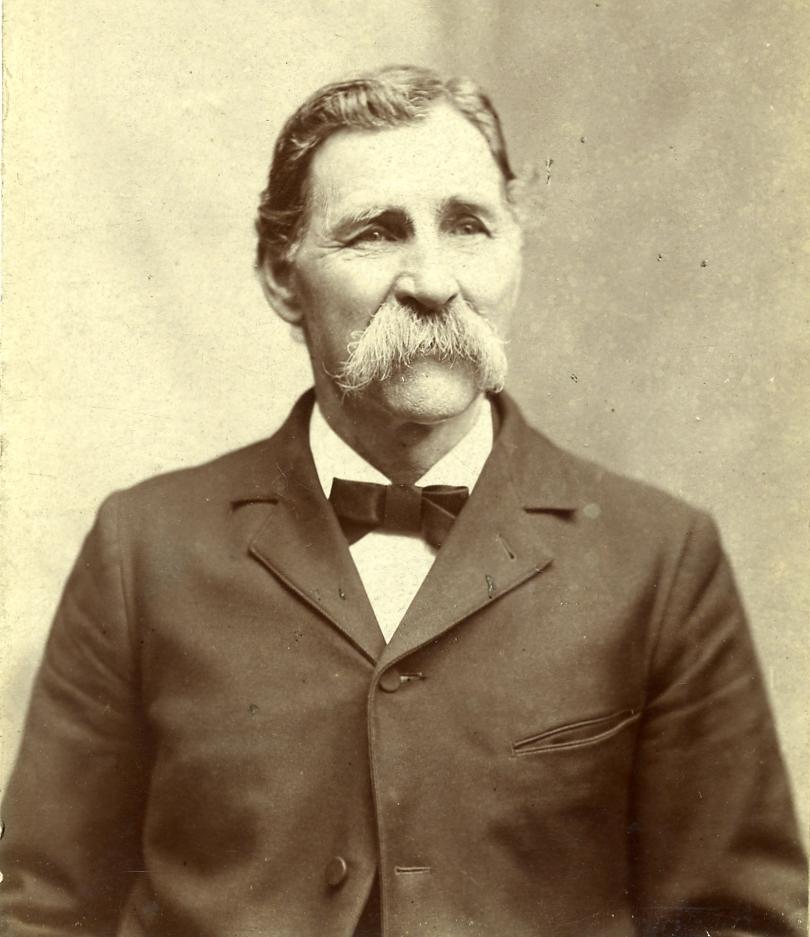 | ( Photo left: Is the only known photograph of Isaac D. Robbins, a tin-type taken in estimated 1890-95)
* Isaac D. Robbins was born in Manchester, Dearborn County, Indiana on March 7th, 1843. He was fifth born to Elijah C. (of Germany) and Ann Robbins ( Grinham – Maiden name, of England). He received his early grade education in Manchester, Indiana as well. His siblings, Daniel, Ann , Richard, & Montraville (served with the 68th Indiana Infantry in Company “K”), Isaac was the youngest. His home area consisted of towns along the Ohio River in Dearborn County, Lawrenceburg , Aurora, Wrights Corner, & others. August 30th, 1861 , he enlisted into the Union Army as a private, accredited from Manchester, he was officially enlisted in the city of Indianapolis by Captain Jumper and then mustered into Company “K” of the 26th Infantry of Indiana Volunteers. From his military records he was identified in having light hair, blue eyes, and was of light complexion at the time, it also stated he was estimated at Six feet tall. |
*Missouri: Isaac’s regiment entered into their first action in Fremont’s campaign against Springfield, Missouri during the dates of September 22nd, through November 3rd, 1861. At various times, Pvt. Robbins would be briefly assigned to duties in Missouri’s townships of Rolla, Sedalia and other Missouri townships in the operations in the South west area of the state during Schofield’s campaign , when and where Pvt. Robbins was during the campaign is not documented.
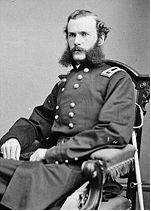 | (Photo left: Brig. General Francis Jay Herron, Union Army. He was awarded the Medal of Honor. b. 1837 – d. 1902) |
*Battle of Prairie Grove: After the sacking of Newtonia , Missouri, Pvt. Robbins company “K” was sent to assist and participate in the occupation. During the dates of October 11th and December 3rd ,1862, The 26th Indiana received orders to proceed into Arkansas to add strength to the forces under the command of General James Blunt.
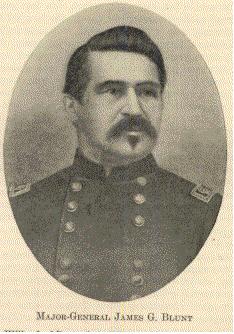 | ( Photo left: General James Gillpatrick Blunt ,Union Army, b. 1826 – d. 1881) |
* When the 26th Indiana arrived, they found them selves being prepared for battle at Prairie Grove, Arkansas. On December 7th, 1862, under the Command of Brigadier General Francis Herron, Commanding the Second & Third Division, Army of the Frontier, and the 1st brigade was commanded by Colonel John G. Clark, which consisted of the 2nd Illinois Light Artillery, Battery “A”, 26th Indiana Infantry, and the 7th Missouri Cavalry. There Confederate enemy was Maj. Gen. Thomas C. Hindman, & Generals Marmaduke, Parsons, and Frost. This was Pvt. Isaac Robbins first major battle, his regiment was positioned 200 yards from the Border Family home & cornfield in which the home & field were on a high ridge and the Confederates had the house and field heavily occupied by troops. Upon the order to charge up the ridge the 26th Indiana and 37th Illinois were met with extreme musket and small arms fire, along with canister fire from confederate cannons ,the casualties were very high & bloody in Company K. Company K was under the command of Capt. A.D. Rose. When the confederate batteries became silent. Brig.Gen. Herron was ordered to move forward the two infantry regiments from his division to support the infantry of the other division, in which they were falling back after a desperate assault of the enemy’s position in which the Confederates were covered by the thicket of bushes and leaves and a fence line, the union infantry that was falling back was cut up very badly, and Herron ordered the 26th Indiana and the 37th Illinois into the charge on the double quick, these two regiments were under the command of Col. Daniel Huston, Jr.
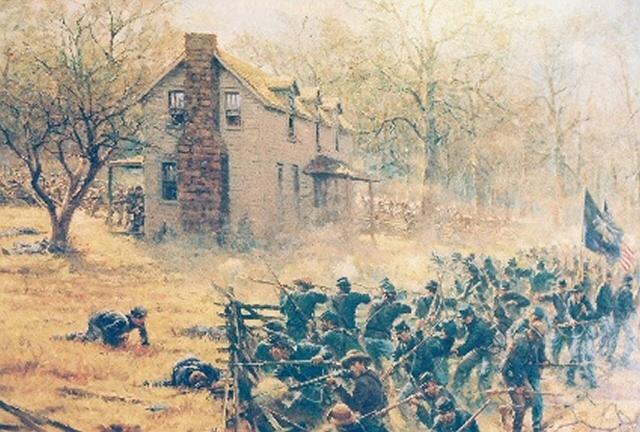
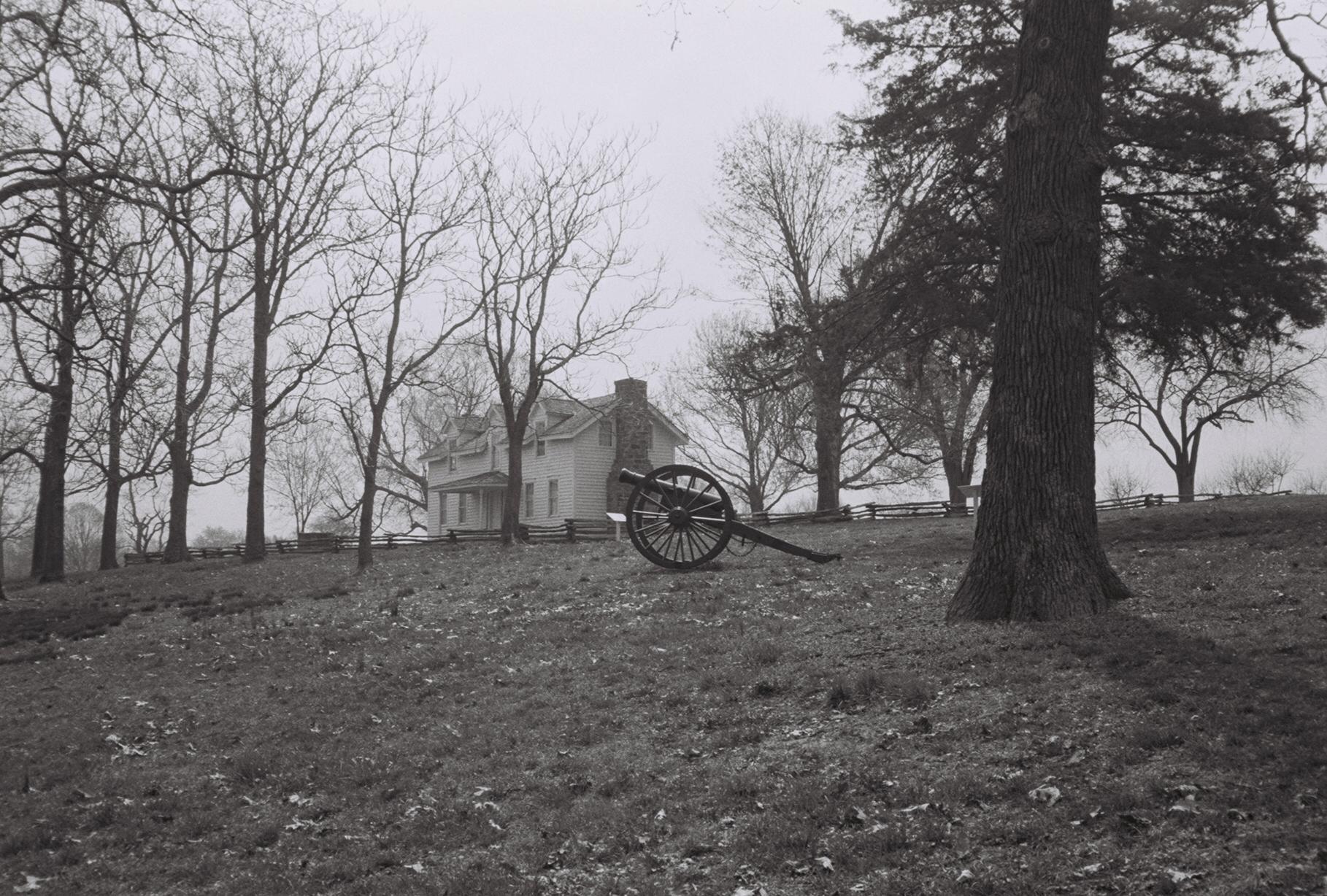 ( Above Photo, is the line of the attack from the view of the 26th Indiana Infantry and 37th Illinois Infantry, in the distance is the Border Family home)
( Above Photo, is the line of the attack from the view of the 26th Indiana Infantry and 37th Illinois Infantry, in the distance is the Border Family home)
When the two regiments reached the crest of the ridge about 75 yards from the Border Family home, the enemy rose out of the leaves and bushes in over whelming numbers and laid a gall of fire in the two union regiments , they with stood the battle and returned fire for some time, but the preponderance of the numbers of the Confederates was so great, the 26th Indiana and the 37th Illinois eventually had to with draw and with some confusion , but soon re-grouped in good order. Colonel Daniel Huston ,Jr. commanding the 1st brigade of the 2nd division, with in the 1st brigade, the 26th Indiana infantry was commanded by Col. John G. Clark, and the 37 Illinois infantry was commanded by Col. John Charles Black, the two regiments remained 250 yards from the top of the ridge, they remained at the base of the ridge until the close of the battle. In the end, Maj. Gen. Thomas C. Hindman 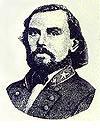 (Photo left: Maj. General Thomas Carmichael Hindman, CSA, b. 1828 – d, 1868) was pushed back to Rhea’s Mill, then past Canes Hill. The battle was a class “B” battle, but a major Union victory the same, the Army of the Frontier entered Arkansas like a flood. By December 13th the 26th Indiana found them selves in Fayetteville to gain rations and supplys. After the sacking of Van Buren, the troops under Maj.Gen. Francis J. Herron returned to the south-west operations in Missouri. The 26th Indiana Infantry engaged in duties (Garrison, occupation, Guard/Sentry) in Cross Hollow, Pea Ridge, Keetsville, Cassville, marching closer and closer to Camp Gamble, through Elk Creek, and the Gasconade River, then posted at Little Piney , 1 ½ miles outside of Rolla, Missouri. The 26th Indiana proceeded on the “ Iron Mountain Railroad” and finally arriving at Fort Gamble. *
(Photo left: Maj. General Thomas Carmichael Hindman, CSA, b. 1828 – d, 1868) was pushed back to Rhea’s Mill, then past Canes Hill. The battle was a class “B” battle, but a major Union victory the same, the Army of the Frontier entered Arkansas like a flood. By December 13th the 26th Indiana found them selves in Fayetteville to gain rations and supplys. After the sacking of Van Buren, the troops under Maj.Gen. Francis J. Herron returned to the south-west operations in Missouri. The 26th Indiana Infantry engaged in duties (Garrison, occupation, Guard/Sentry) in Cross Hollow, Pea Ridge, Keetsville, Cassville, marching closer and closer to Camp Gamble, through Elk Creek, and the Gasconade River, then posted at Little Piney , 1 ½ miles outside of Rolla, Missouri. The 26th Indiana proceeded on the “ Iron Mountain Railroad” and finally arriving at Fort Gamble. *
(below, Illustrations of the Naval conflict at Vicksburg) Siege of Vicksburg: On June 4th, 1863, Col. John G. Clark received orders to take the 26th Indiana to Saint Genevieve to embark on the SS Hannibal ( the SS Hannibal was a side Wheel Paddle steam ship built in Belle Vernon, Pa. in 1856 on the Monogahela River about 40 miles north of Pittsburgh. The vessel weighed 497 tons, the measurements was 226 ft. long x 36 ft. in width x 7 ft. in depth, and the engines were 24 ft. in bore with 7 ft stroke. It was equipped with four boilers. Its commercial route was St. Louis to New Orleans , during 1863, the steam ship was under the command of Captain Terry Bell, in October 1863 the vessel snared an obstacle and sank five miles north of Fort Butler, in Donaldsonville, Louisiana ) and proceed down River to Young’s Point, Louisiana. The 26th Indiana arrived at Young’s point on June 13th, and on the 15th, crossed the river and take up positions on the extreme left lines of Vicksburg, Mississippi ( south-west lines of the siege, The Union Navy was bombing from the west, as the Union Military land forces was engaging attacks from the south ,east & north sides of the city ). On June 22nd ,Company’s C, E, and K of the 26th Indiana, (Pvt. I.D. Robbins present) under their regimental commanding officer , Col. John G. Clark, advanced with a three company recon patrol, in the course of the mission they successfully captured eleven Confederate soldiers & seized their arms and equipment, and occupying three of their rifle pits. By June 25th, the 26th Indiana were 1,200 yards and by July 3rd, 600 yards of the enemy’s line of forts.
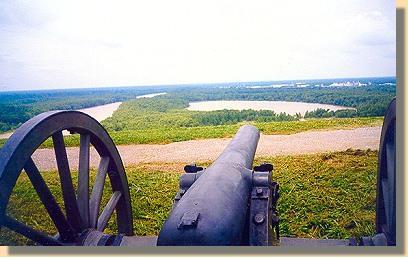
(above Photo: A Vicksburg Cannon on the west side of Vicksburg, in the distance , the Mississippi River )
Maj. General Francis Herron had established at the left front a battery of 42-pounder rifle guns. During the siege , several Confederate rifle pits in front of Herron’s division, were engaged in a major exchange of fire, a good number of Confederate soldiers were taken prisoner . On July 3rd, 1863 Maj. General Ulysses Samuel Grant sent a dispatch to Herron, ordered a cease fire, the surrender of Vicksburg was at hand. On July 4th, 1863 (Independence Day), Confederate General John C. Pemperton surrendered the City of Vicksburg , Mississippi , the Union Army under the leadership of Maj. Gen. U.S. Grant took control of Vicksburg, Herron’s Division was one of the divisions that participated in the taking and occupation of the City of Vicksburg, Herron’s division had a three mile coverage marching into the rear of the city. Leading at the head of the occupying divisions into Vicksburg was Maj.Gen. Ulysses Samuel Grant. The Union Military had full control of the Mississippi River. The Anaconda Plan ( created by Sec. of the Navy, Gideon Wells) has been fully accomplished. On July 12th, 1863, Herron’s 1st brigade (26th Indiana present) was ordered up the Yazoo, river that is, and re-capture Yazoo city, Mississippi. They succeeded . On July 21st they arrived back to Vicksburg. On July 26th the 26th Indiana and 19th Iowa embarked on the SS Arago, and was transported down the Mississippi river to Union occupied Port Hudson, Louisiana. They camped just outside of the port.
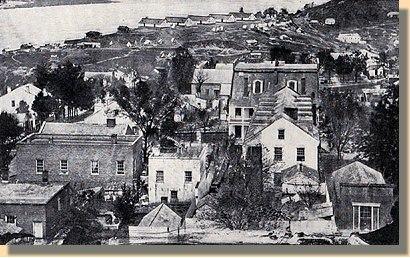
(a pre-battle photograph of the city of Vicksburg, Mississippi in 1862) Battle of Stirling’s Plantation: On September 14th, 1863, the 26th Indiana Infantry, the 20th and 34th Iowa, and 37 Illinois under the command of Lt. Col. J.B. Leake, was ordered to proceed to the vicinity of “Atchafalaya Bayou” , on Sept. 20th, the 26th Indiana Infantry along with the 19th Iowa arrived in the vicinity of Morganza Bend in the Fordoche Bayou, Louisiana. Lt. Col. Leake met the Confederates at their pickets at Fordoche bridge on Morganza state road on September 29th, the 19th Iowa was attacked from all sides , the Confederate forces was under the command Brig. Gen. Thomas Jefferson Green, 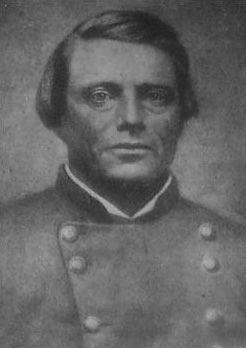 (Brig. Gen. Thomas Jefferson Green, CSA. b. 1814 – d.1864) the first advance was made my the Union’s 19th Iowa , their retreat route was cut-off by the Confederates. Brig. Gen. Green attacked the 19th Iowa from the front. The 26th Indiana Infantry arrived from the rear , re-enforcing the 19th Iowa. Both the 26th Indiana and the 19th Iowa delivered a heavy volley of fire, then was pushed back to Stirlings Plantation, near Morganza bend, a few miles from Union occupied Morganza township, but Confederate Brig. Gen. Green rallied back with over-whelming force, the 26th Indiana & 19th Iowa was compelled to surrender. Confederate Brig. Gen. Green had a force of 5,000 men, while Union Lt. Col. Leake had only 500 men. The union casualties consisted between the two regiments, 2-Officers, & 8-enlisted men dead. 11-Officers and 203-enlisted men ( Pvt. Isaac D. Robbins was one of the enlisted men ) were captured. The rest retreated back to Morganza, some wounded and mortally wounded. Union Lt. Co. J.B. Leake gone down wounded and was captured.
(Brig. Gen. Thomas Jefferson Green, CSA. b. 1814 – d.1864) the first advance was made my the Union’s 19th Iowa , their retreat route was cut-off by the Confederates. Brig. Gen. Green attacked the 19th Iowa from the front. The 26th Indiana Infantry arrived from the rear , re-enforcing the 19th Iowa. Both the 26th Indiana and the 19th Iowa delivered a heavy volley of fire, then was pushed back to Stirlings Plantation, near Morganza bend, a few miles from Union occupied Morganza township, but Confederate Brig. Gen. Green rallied back with over-whelming force, the 26th Indiana & 19th Iowa was compelled to surrender. Confederate Brig. Gen. Green had a force of 5,000 men, while Union Lt. Col. Leake had only 500 men. The union casualties consisted between the two regiments, 2-Officers, & 8-enlisted men dead. 11-Officers and 203-enlisted men ( Pvt. Isaac D. Robbins was one of the enlisted men ) were captured. The rest retreated back to Morganza, some wounded and mortally wounded. Union Lt. Co. J.B. Leake gone down wounded and was captured.
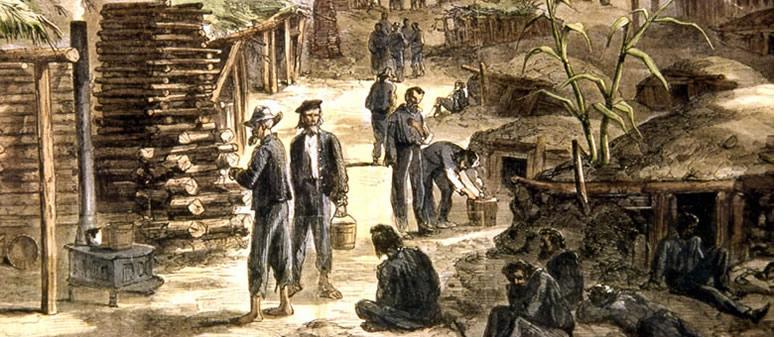
( Above Illustration, Prisoners of Camp Ford.)
CAMP FORD, Confederate Prison, Tyler, Texas:
The Union men ( officers & enlisted) were marched through Alexandria, Louisiana, also they were held for a few days in that area in a Court house room. Then the prisoners were marched through Natchitoches, Mansfield, and Shreveport, Louisiana. By mid-October of 1863, the Union prisoners arrived at Tyler, Texas, and placed as inmates in Camp Ford, Confederate Prison. It was the biggest Confederate Prison west of the Mississippi River. The Confederate “ commander of the guard “ was Major Thomas F. Tucker, the commanding Officer (the commandant) was Colonel R.T.P. Allen 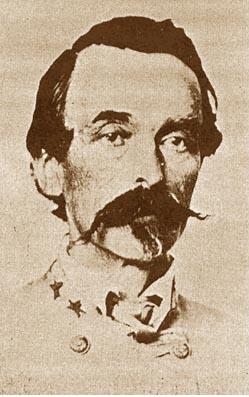 (photo left. ) ( a west point graduate), this would be Private Isaac D. Robbins home until February of 1864. While at Camp Ford, an inmate by the name of Captain Amos Johnson of the Union Naval vessel “ USS Sachem “ was designated as “ Commissioner of Aqueducts “ , with his fellow inmates, they manage to build two reservoirs adjacent to the spring, the upper one was for drinking, and the lower one was for bathing. The fact that the prisoners safe-guarded their water supply did more to insure their health on a fair level. The sinks & latrines were located at the lowest portion of the prison camp on the south-east corner of Camp Ford, coining the phrase: “ dung doe’s float down stream”. During Pvt. Isaac Robbins stay at the prison camp along with his 26th Indiana comrades took a major hit to their morale when two of their comrades was shot senselessly by a Confederate Guard. Since Regiments stayed in their regimental groups , they maintained a type of formation with in the prison system. One of the men shot was from the 26th Indiana, his name was Pvt. Thomas Moorehead. Pvt. Moorehead was waiting in line for wood. A Confederate guard by the name of Frank Smith ordered Pvt. Moorehead to fall back, while turning to fall back, Smith fired a single shot that went through Mooreheads mid body section, passing through him and shattering the arm of another Union inmate. That same night, both soldiers died from their wounds. This brutal act, this war atrocity enraged the prison population. Pvt. Isaac Robbins and his Comrades of the 26th Indiana saw this horrific act on a most personal level. As the prison population fueled their enragement for revenge, the men were on the edge of a major riot, they delivered a threat to the confederate guards, that the Union prisoners will rise up and massacre the guards and the people in the near by town as well. And the men of the 26th Indiana was all for it and wanted to put this threat into immediate motion & action. But the highest ranking Union inmate, Lt. Colonel Joseph B. Leake, manage to defuse the threat and being very educated, he counseled the prison population with reason and tact. He did not be-little any man because of lack of education. He calmed the Union men, inferring upon Union Victory of the war, Confederate men of atrocity will be prosecuted and punished for their crimes by the law of the land.
(photo left. ) ( a west point graduate), this would be Private Isaac D. Robbins home until February of 1864. While at Camp Ford, an inmate by the name of Captain Amos Johnson of the Union Naval vessel “ USS Sachem “ was designated as “ Commissioner of Aqueducts “ , with his fellow inmates, they manage to build two reservoirs adjacent to the spring, the upper one was for drinking, and the lower one was for bathing. The fact that the prisoners safe-guarded their water supply did more to insure their health on a fair level. The sinks & latrines were located at the lowest portion of the prison camp on the south-east corner of Camp Ford, coining the phrase: “ dung doe’s float down stream”. During Pvt. Isaac Robbins stay at the prison camp along with his 26th Indiana comrades took a major hit to their morale when two of their comrades was shot senselessly by a Confederate Guard. Since Regiments stayed in their regimental groups , they maintained a type of formation with in the prison system. One of the men shot was from the 26th Indiana, his name was Pvt. Thomas Moorehead. Pvt. Moorehead was waiting in line for wood. A Confederate guard by the name of Frank Smith ordered Pvt. Moorehead to fall back, while turning to fall back, Smith fired a single shot that went through Mooreheads mid body section, passing through him and shattering the arm of another Union inmate. That same night, both soldiers died from their wounds. This brutal act, this war atrocity enraged the prison population. Pvt. Isaac Robbins and his Comrades of the 26th Indiana saw this horrific act on a most personal level. As the prison population fueled their enragement for revenge, the men were on the edge of a major riot, they delivered a threat to the confederate guards, that the Union prisoners will rise up and massacre the guards and the people in the near by town as well. And the men of the 26th Indiana was all for it and wanted to put this threat into immediate motion & action. But the highest ranking Union inmate, Lt. Colonel Joseph B. Leake, manage to defuse the threat and being very educated, he counseled the prison population with reason and tact. He did not be-little any man because of lack of education. He calmed the Union men, inferring upon Union Victory of the war, Confederate men of atrocity will be prosecuted and punished for their crimes by the law of the land.
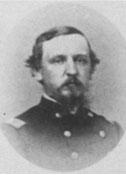
(Photo Above : Lt. Col. Joseph Bloomfield Leake, 20th
Iowa regiment, Camp Ford , P.O.W. b. 1828 – d.1913) Shreveport, Louisiana.: * On November 27th, 1863: Private Isaac D. Robbins and other men of the prison camp received notice of parole, the following day , they were marched to parole camp at Shreveport, Louisiana. It was a 110 mile march, they arrived at the parole camp in early December. In early January of 1864, the parolee’s received notice, that all paroles were delayed and not denied, but the Union inmates were required to march back to their Camp Ford hell in Texas and await for another exchange date.
* St. Louis USA General Hospital, New Orleans, La.: NOTE: In Isaac Robbins military records there was a muster Hospital roll, that documented his entry into St. Louis USA General Hospital in New Orleans, Louisiana on February 14th, 1864, he was picked up a Lakes End, Louisiana. Family stories past down, records that he did escape, most likely from the Parole March back to Camp Ford. The stories indicated that Pvt. Isaac D. Robbins gorged his appetite on a garden patch of “tomato’s “, when he was finished , he became seriously ill. The Hospital record indicated he was admitted with severe stomach pain. Though he was scheduled with other inmates to be exchanged at the mouth of Red River in July of 1864, records prove that he was not at that exchange. The escape theory comes into line with the records. Private Isaac D. Robbins was released from St. Louis General Hospital in May of 1864.
* Fort Butler: Private Robbins was forwarded to Fort Butler in Donaldsonville, Louisiana on “orphan status “, meaning he is a soldier separated from his regiment and is waiting for retrieval. At the time of Pvt. Robbins stay at Fort Butler, the 26th Indiana was engaged in the Red River Campaign at the Rio Grande. On July 12th, 1864, Colonel John G. Clark arrived the 26th Indiana Infantry at Fort Butler. Pvt. Robbins rejoined the ranks. On July 22nd, 1864 the exchange took place at the mouth of Red River, and later Col. John G. Clark regained the men of the 26th Indiana who survived the incarceration at Camp Ford.
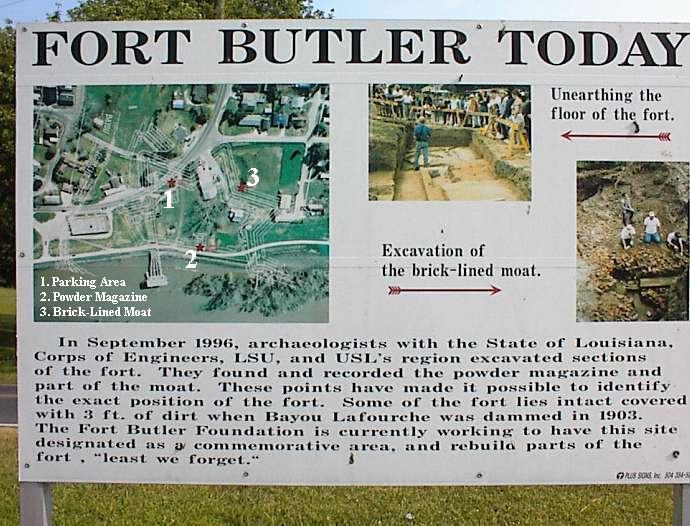
(Above Photo: a sign at the site of the Fort Butler, La. Excavation, only bits and pieces of the old fort can be seen today)
Discharged: On August 30th, 1864, a large portion of the 26th Indiana Infantry’s term of service expired, including Private Isaac D. Robbins of Company “K”. The men that were to be discharged made their way to Indianapolis, where they received there honorable discharges. Where Private Robbins went after his discharge is unknown and undocumented ( not discovered yet) most likely returned home to Dearborn County. But re-surfaced in Greensburg, Indiana in February of 1865.
2nd enlistment – 146th Indiana Infantry volunteers, co.”G”.:
On February 7th, 1865, Isaac D. Robbins re-enlisted into Company “ G” of the 146th Infantry of Indiana Volunteers out of Greensburg, Indiana. The regiment had its first active duty muster on March 9th, 1865, due to Pvt. Robbins previous war experience, he was promoted to the rank of Sergeant. He was now SGT: Isaac D. Robbins. In late March of 1865, the left for their first assignment at Harper’s Ferry, in Virginia, where the 146th Indiana was attached as one of the provisional divisions of the “ Army of the Shenandoah” . The regiment was mostly used for garrison and railway duty, at places like Charlestown, Winchester, Stephenson’s Depot, Jordan Springs, & Summit Point until July 27th, 1865, then the 146th Indiana was ordered to Baltimore, Maryland and was assigned to the Military District of the Delaware , various company’s were assigned in different areas of the district, one at Hicks General Hospital in Baltimore, one in Dover, one at Wilmington, one at Salisbury, and one at Carrolton, which company went where is still under research, SGT: Robbins military records was not specific on which company was posted in which township. They most likely traded township positions upon post & guard rotation.
The War of the great Rebellion comes to an end: On April 9th, 1865 the American Civil War came to an end at the home of Wilmer & Virginia McLean in the town of Appomattox Court House in Virginia. After four years of war, approximately 630,000 deaths and over 1 million casualties, General Robert E. Lee surrendered the Confederate Army to General Ulysses S. Grant. General Lee arrived about 1 pm on his horse named “ Traveler” followed by Grant a half hour later, the two Generals left the building and hour and half later, and the war came to an end. The last of the Confederate army’s submitted to surrender on June 23rd, 1865. There were still rogue units about, but eventually surrendered by the end of 1865.
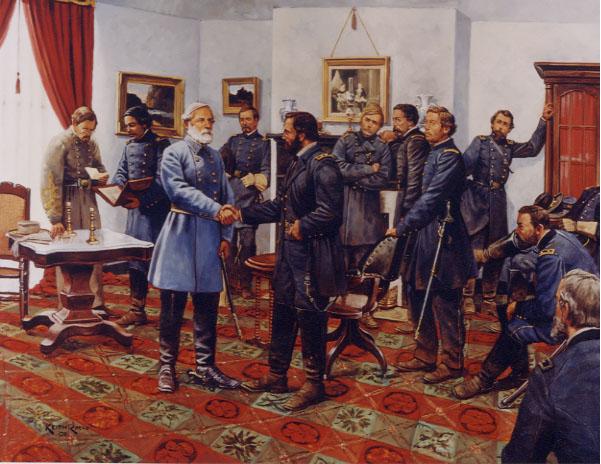
( Illustration below: of the inside of the Mclean home.)
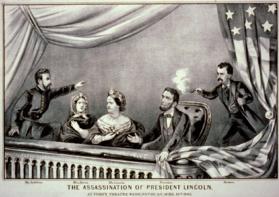
The Lincoln assassination:* On April 14th, 1865, southern actor John Wilkes Booth murdered President Abraham Lincoln at Ford’s Theatre during the play “ Our American Cousin” Booth was the ring leader in a wide range conspiracy. After the shot was fired, Booth cried “Sic Semper Tyrannis” latin for “ Thus always to tyrants”.

( Photo is of the actual pistol Booth used in the assassination)
Booth leaped from the presidential balcony to the stage breaking his leg. And made his escaped, days later he was shot by a Union Soldier at Garrets Farm as they were trying to force him out by burning the Garret barn. The president survived only a day after the shot was fired, he was taken to an Inn across the street from Ford’s theatre. He died at 7:22 am on April 15th. The 146th Infantry Indiana Volunteers was so spread out in duties in many townships, where SGT: Isaac Robbins was at the time is still under research. His Military records did not reveal in depth accounts of his duties during this horrific crime in our nation’s history. On June 30th, Assassination conspirators, Lewis Powell, David Herold, George Atzerodt, and Mary Surratt were sentenced to Hang, on July 7th, the sentence was carried out at the “Old Arsenal Penitentiary”. 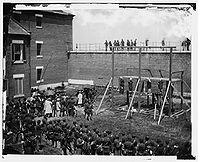
(Photo of the Hanging of Surratt, Herold, Powell, and Atzerodt, on July 7th, 1865 ) Three men were sentenced to life in prison , Dr. Samuel Mudd was sent to Fort Jefferson Prison on Dry Tortugas in the Florida Keys – he set Booths broken leg, Edmond Spangler held Booths horse during the assassination, received a six year sentence. Other life sentence was extended to Sam Arnold, and Michael O’Laughlen. Dr. Mudd, and Mr. Arnold were pardoned by President Andrew Johnson in 1869. Michael O’Laughlen died in prison from Yellow fever in 1867. Dr. Sam Mudd and Mary Surratt’s guilt in the assassination conspiracy is still held in controversy to this very day.
The 2nd discharge:
The men of the 146th Infantry of Indiana Volunteers, Company “G” was mustered out of service on August 31st, 1865, along with many other units. Some called them the 100 day units, but most were mustered out between 150 and 200 days of service. Sergeant Isaac D. Robbins is now a retired war veteran. Mr. Robbins returns home to Dearborn County, Indiana. The most likely route Mr. I.D. Robbins would of taken home, is by way of the Ohio River on a steam / riverboat.
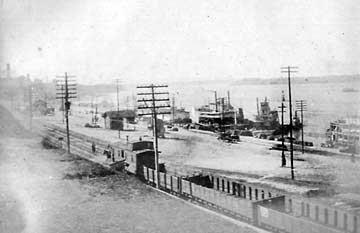
(Photo left: River docks on the Ohio River in Dearborn County, Indiana, circa 1900.)
Civilian Life of Isaac D. Robbins:
Its been about 5 years Mr. Robbins since he arrived home from the war, and not much was documented on what he did during that time. But on December 1st, 1870 in Rising Sun, Ohio County, Indiana, Isaac D. Robbins married Hester Ann Neal, the Minister that performed the wedding was Rev. N.J. Jolly. Isaac and wife Hester resided in Aurora, Indiana. They soon had their first born, a daughter named Priscilla Ann Robbins on May 9th, 1871, whether they owned, or rent a home, is unknown, but the family did travel to Kentucky, where they had their second born, a son named: John Neal Robbins born on December 1st 1873. Isaac & Hester and their two children traveled to York, Nebraska, to try homesteading , most likely an invitation by Isaac’s elder brother Montraville (a Civil War Veteran from the 68th Indiana) who also lived in York, Nebraska. Isaac’s brother was a large land owner, and owned one of the finest homes in York. The family obtained a spot of land & began to farm , and built their first home out of sod. Later they had their third born, a son, named Montraville G. Robbins. ( duh! Named after Isaac’s brother ) born on February 1st, 1876. And later on, they had their fourth born, a daughter named Mabel E. Robbins ( the E. may have stood for Eliza, but that has not yet been confirmed, no documentation has been found to identify the middle name.) she was born on May 16th, 1881. A few years later, the Robbins family returned to Aurora, Indiana and purchased a home. The children gained their early education in Aurora. The children eventually married, Priscilla Ann married Clark Morgan Savage on February 5th, 1890, and there family and descendants remain in the area of Dearborn county to this very day. John Neal Robbins married a woman by the name of Charlotte ( “Lottie”- her maiden name is still unknown at this time). Also there is no information on third born Montraville G. Robbins or who he married or remained single. Mabel E. married Hiram (“Hilo”) Cox Swift on June 6th, 1899 in Dearborn County, Indiana. Seeing that they had more room that they needed, Isaac & Hester sold their home to John & Charlotte Robbins on October 25th, 1899 for the sum of $300 dollars. Isaac & Hester retired in a smaller home in the Aurora area. Isaac D. Robbins was a devote member of the fraternal order of the “ GRAND ARMY OF THE REPUBLIC” and was a member of the “ Colonel Platter GAR Post # 82 “ based out of Aurora, Indiana. On July 17th, 1901, tragedy struck the heart of Isaac Robbins, wife Hester Ann , passed away and he lost the love of his life. She was born in Rising Sun, Indiana on April 20th 1852, she was laid to rest in the Olive branch section, Lot #3 of “Cedar Hedge Cemetery”, in the old Randolph Township area of Rising Sun, Ohio County, Indiana.
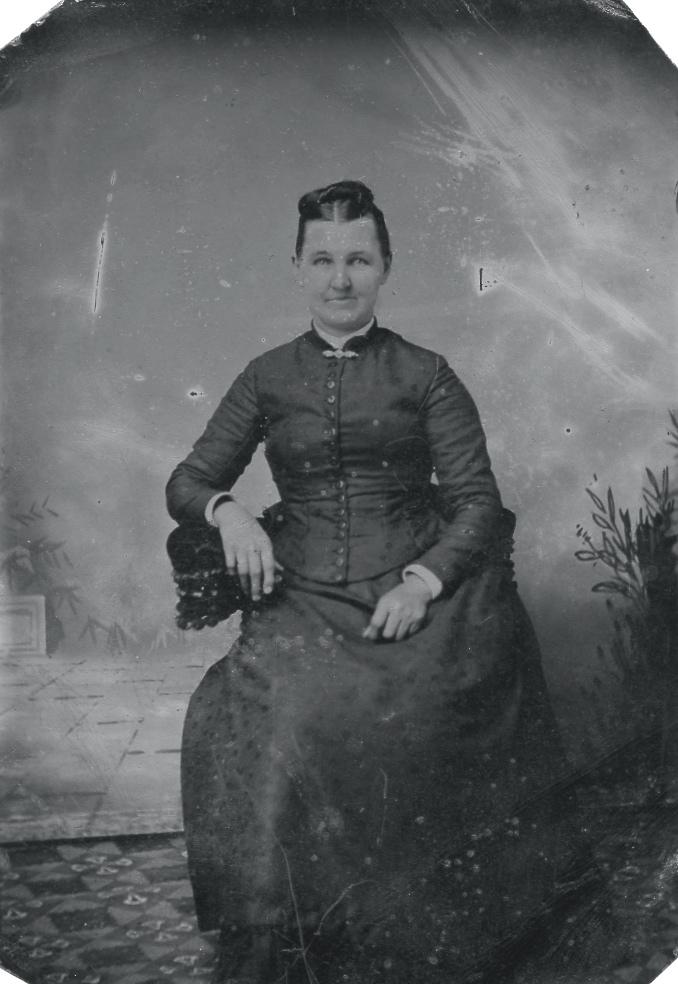 (Photo left: the only known photo of Hester Ann Robbins, b.1852 –d. 1901) The only family members that stayed in the area, that was documented, were John & Lottie Robbins, Hiram & Mabel Swift. Isaac D. Robbins re-married on June 7th, 1905 to a woman named Florence G. True of Lawrenceburg, Indiana. From that second marriage, Isaac & Florence had only one child, as son name Richard Marion Robbins, born in Aurora, Indiana on April 9th, 1906. On February 8th, 1908, Isaac turns ownership of his property over to his 2nd wife Florence. And on November 5th, 1909, Isaac D. Robbins passes away from Stomach cancer. Isaac suffered from random stomach pains all his life since the Civil War. Family stories passed down, indicated he had a strong hatred for tomato’s, every time stomach pain would strike him, he would comment “ those damn tomato’s “ (referring to the tomato patch he gorged his appetite on, during his escape). Isaac D. Robbins ( we never discovered what his middle name was.) was buried next to his 1st wife Hester at Cedar Hedge Cemetery in the Olive Branch section on November 7th, 1909.
(Photo left: the only known photo of Hester Ann Robbins, b.1852 –d. 1901) The only family members that stayed in the area, that was documented, were John & Lottie Robbins, Hiram & Mabel Swift. Isaac D. Robbins re-married on June 7th, 1905 to a woman named Florence G. True of Lawrenceburg, Indiana. From that second marriage, Isaac & Florence had only one child, as son name Richard Marion Robbins, born in Aurora, Indiana on April 9th, 1906. On February 8th, 1908, Isaac turns ownership of his property over to his 2nd wife Florence. And on November 5th, 1909, Isaac D. Robbins passes away from Stomach cancer. Isaac suffered from random stomach pains all his life since the Civil War. Family stories passed down, indicated he had a strong hatred for tomato’s, every time stomach pain would strike him, he would comment “ those damn tomato’s “ (referring to the tomato patch he gorged his appetite on, during his escape). Isaac D. Robbins ( we never discovered what his middle name was.) was buried next to his 1st wife Hester at Cedar Hedge Cemetery in the Olive Branch section on November 7th, 1909.
Researched & Compiled byTimothy Paul Reese
Great-Great Grandson of Isaac D. Robbins
Descendant from Mabel E. Robbins-Swift.
November 9, 2008 (831)422-3619
P.O.Box 1641 Lincoln_10tpr@email.com
Monterey, Calif. 93942 www.suvcw.org
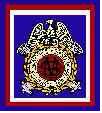
Mr. Reese is a member of the: “Sons of Union Veterans of the Civil War”, “Dept. Calif. & Pacific”.
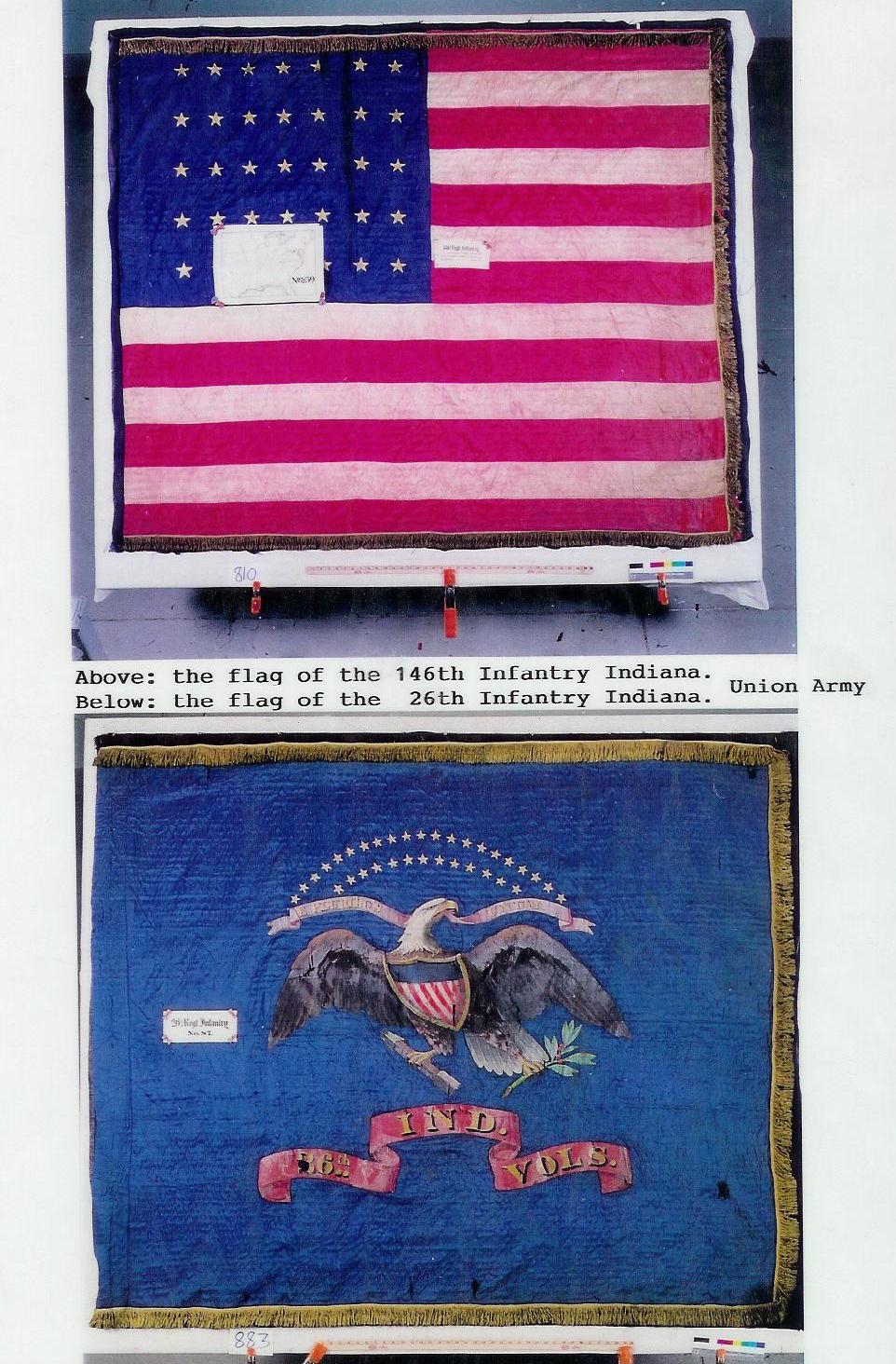
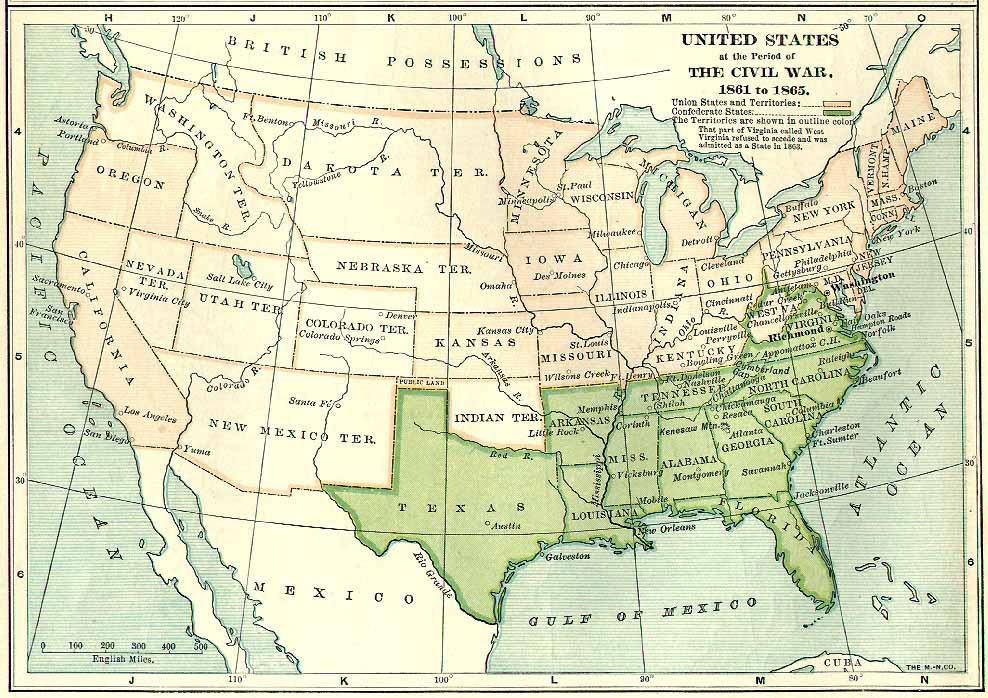 Map of the divided states during the American Civil War, the eleven state Confederacy under President Jefferson Davis shaded in Green, and the Union States under President Abraham Lincoln shaded in light red. And the rest of the U.S. Territories. 1861-65.
Map of the divided states during the American Civil War, the eleven state Confederacy under President Jefferson Davis shaded in Green, and the Union States under President Abraham Lincoln shaded in light red. And the rest of the U.S. Territories. 1861-65.

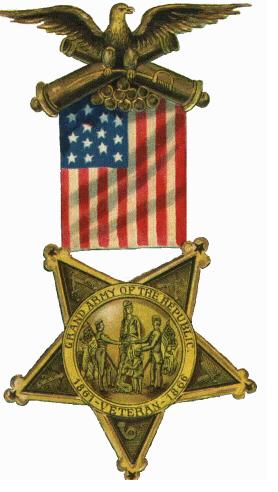
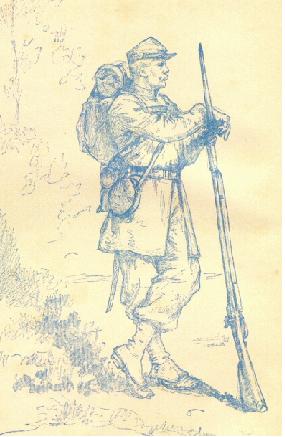
( GAR ribbon of the Colonel John A. Platter, Post #: 82 , of the “ Grand Army of the Republic) , the ribbon worn by Isaac Robbins, based out of Aurora, Indiana, & to the right is the membership badge for the “Grand Army of the Republic, all GAR members wore this badge.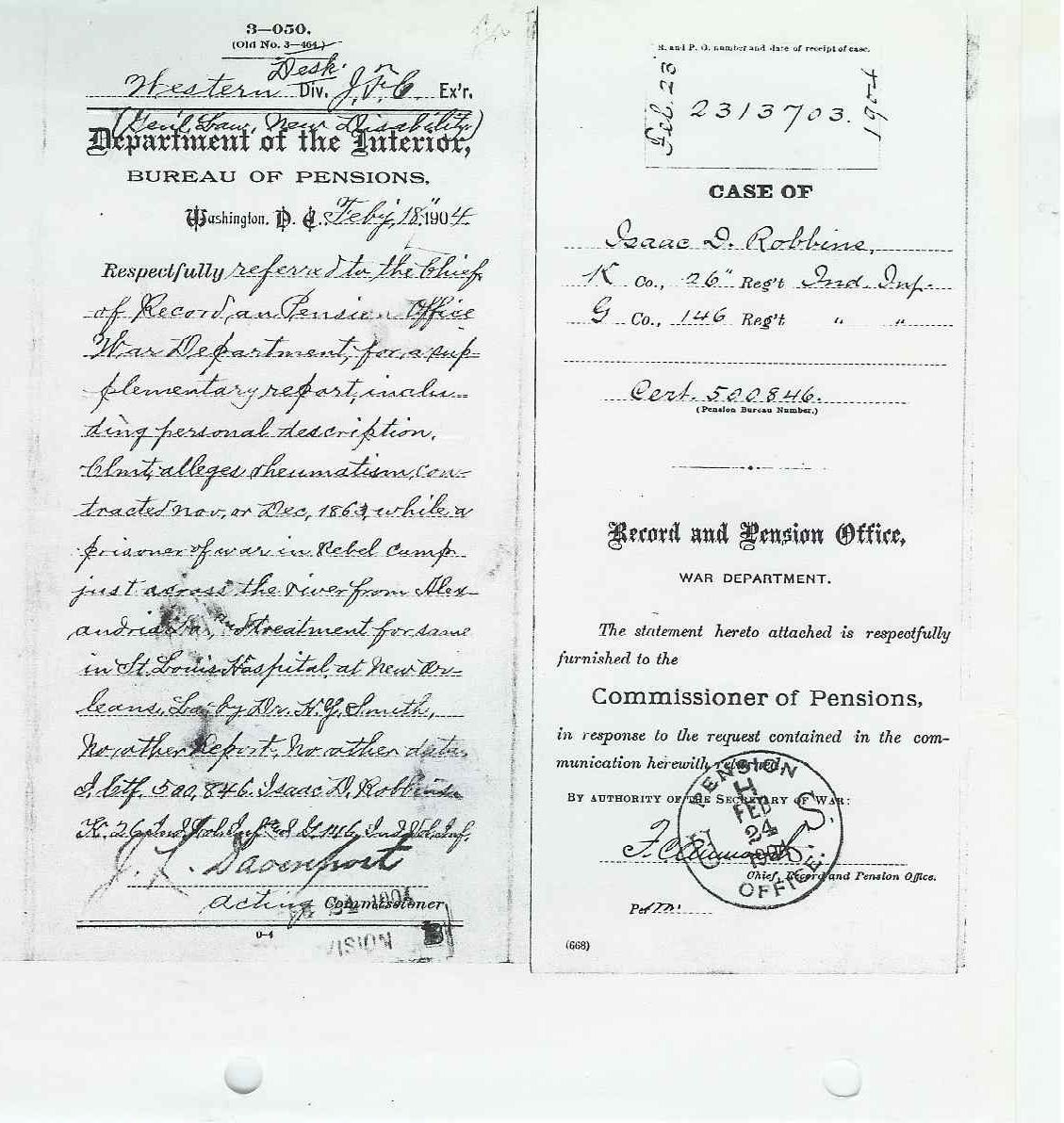
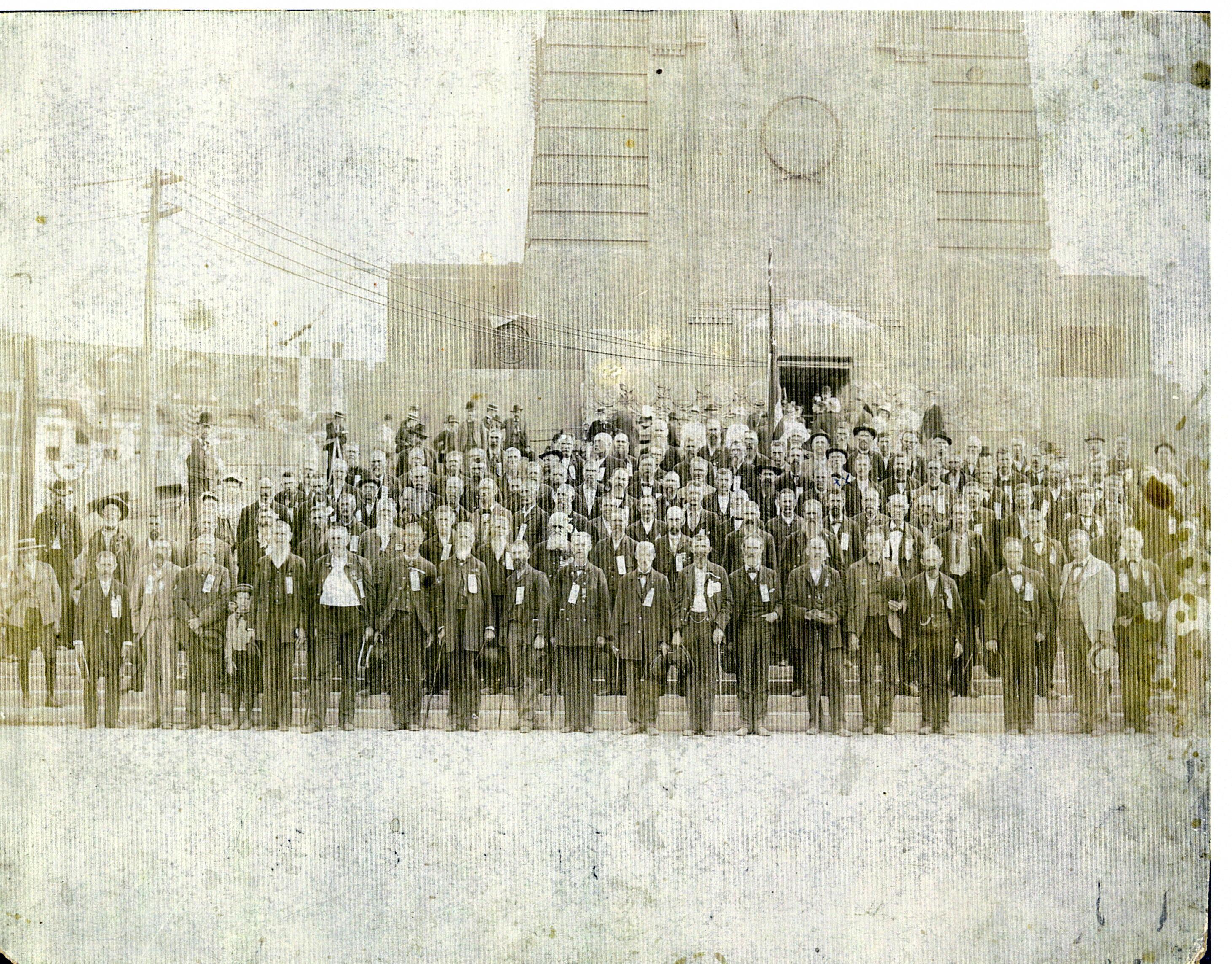
Photograph of the 1903 reunion of the 26th Indiana regiment at the War monument in Indianapolis, Indiana. 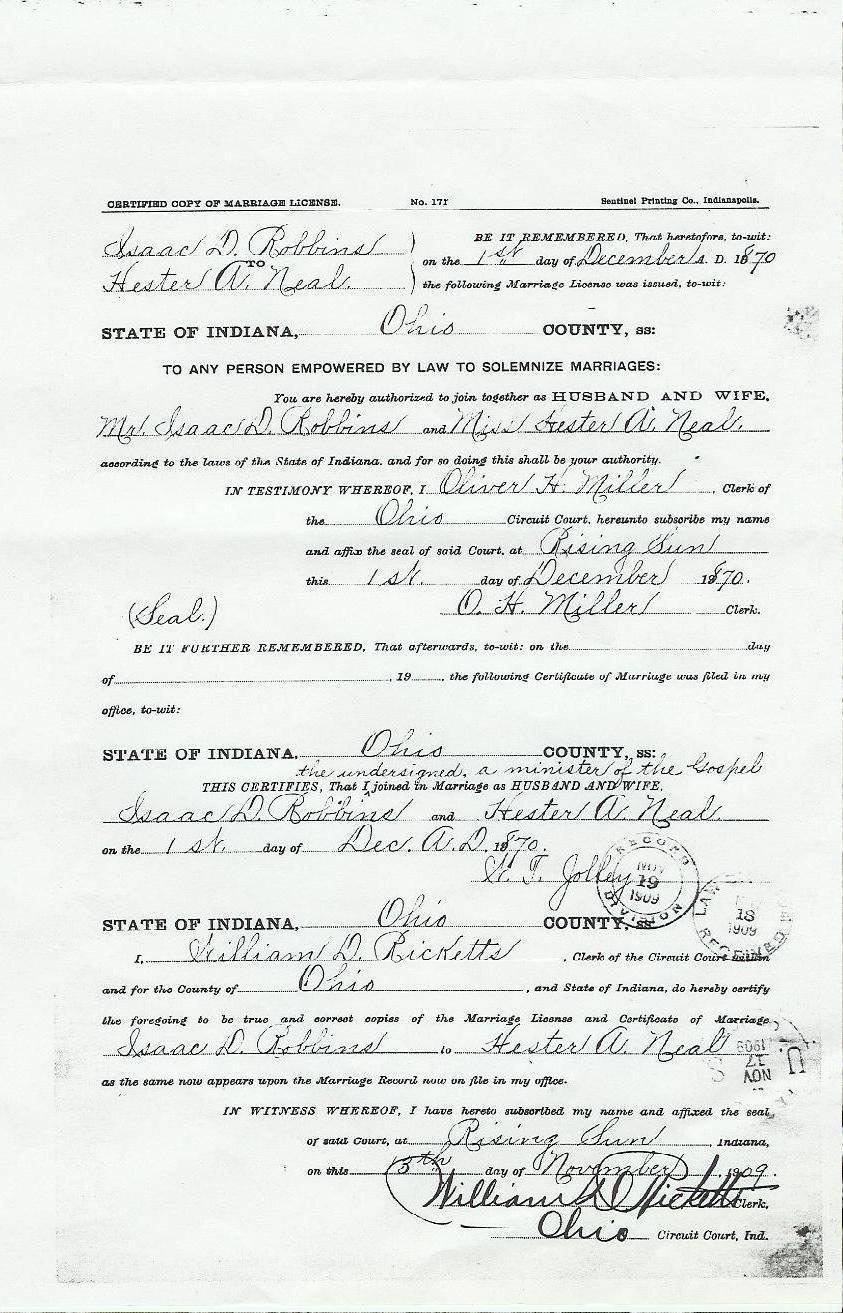
(Photo copy of the marriage certificate between Isaac & Hester Robbins, December 1st, 1870.)
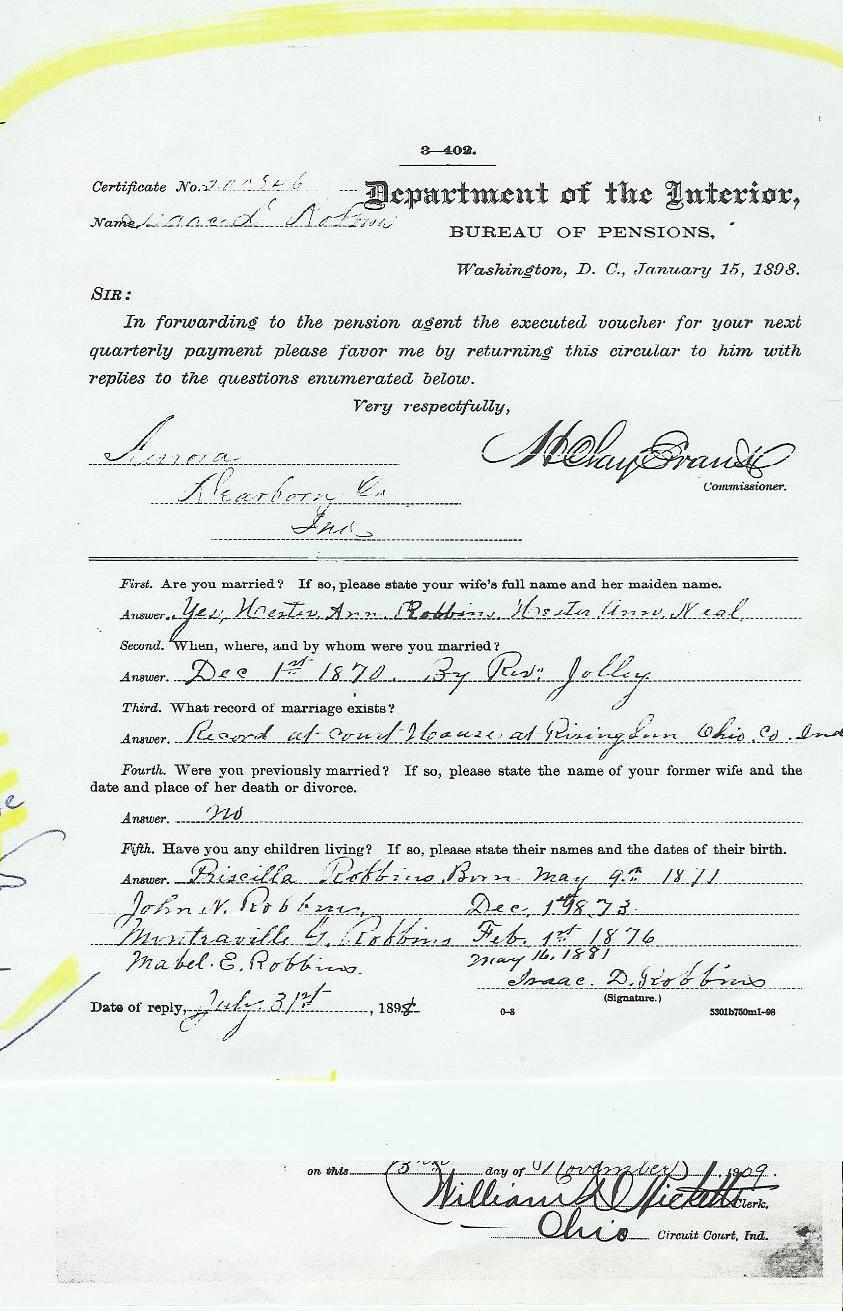
(Record from the Dep. Of Interior, listing Isaac & Hester’s children’s birth dates.)
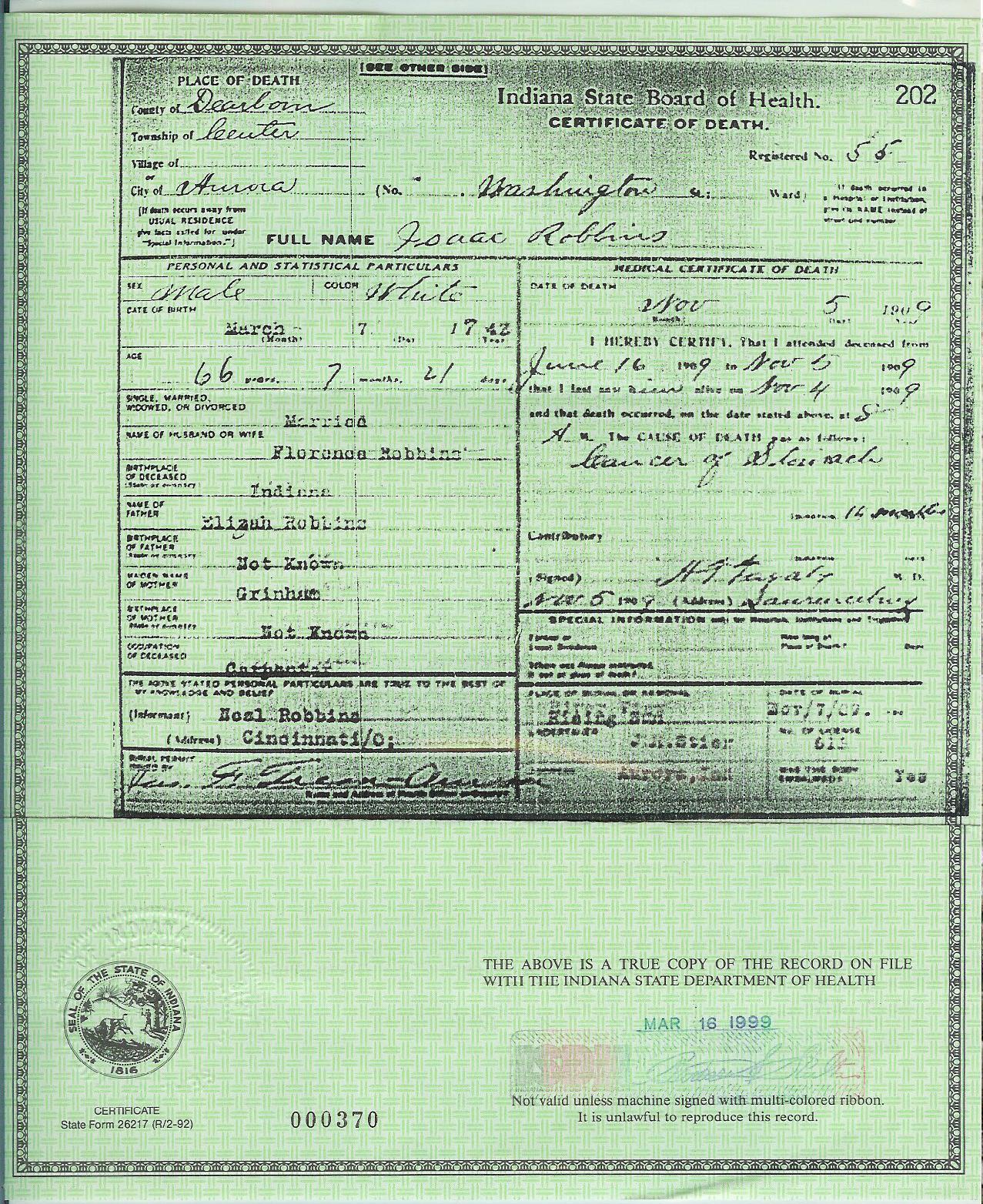
(The Death Certificate for: Isaac D. Robbins)